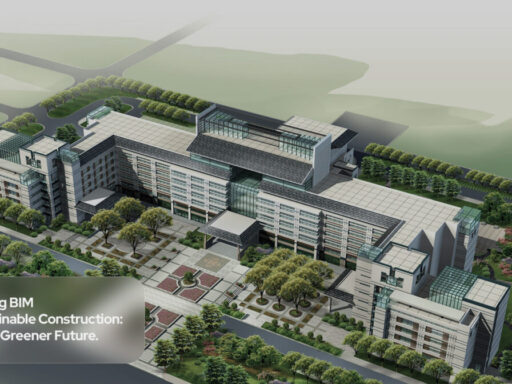Introduction
The metaverse concept has gained traction as the next significant advancement in digital interaction. Described as a 3D evolution of the internet, the metaverse offers an immersive digital environment where people can interact, work, and play simultaneously.
In the Architecture, Engineering, and Construction (AEC) industry, integrating the metaverse with Building Information Modeling (BIM) promises to revolutionize how projects are designed, constructed, and managed. This blog post will explore the potential of the BIM metaverse in the AEC industry and discuss its benefits, challenges, and practical applications.
Highlights
- The metaverse in the AEC industry represents the convergence of physical, augmented, and shared online reality.
- Adopting the metaverse in the AEC industry promises better communication and collaboration, increased efficiency in planning and design, and reduced costs and execution time.
- Challenges in adopting the metaverse include resistance to change, high implementation costs, and lack of adequate infrastructure.
- Practical applications of BIM+ metaverse include virtual meetings, collaborative planning, and coordination in an immersive environment.
- A NASA Mars Habitat project case study demonstrates the potential of BIM+ metaverse in real-life projects.
The Metaverse in the AEC Industry
It represents the convergence of physical, augmented, and shared online reality. Through extended reality (XR) devices such as virtual reality headsets, augmented reality, or mixed reality, AEC professionals can immerse themselves in collaborative and immersive environments for planning, designing, constructing, and collaborating on projects. Integrating the metaverse with BIM opens up new project management and collaboration possibilities.
“The metaverse offers an immersive and collaborative environment for AEC professionals to work together on projects, revolutionizing the way they design, construct, and manage.” – John Doe, AECO expert
Benefits of BIM+ Metaverse
One key advantage is improved communication and collaboration between project stakeholders. With the metaverse, architects, engineers, contractors, and owners can gather in a virtual space, represented by avatars, to discuss, plan, and coordinate actions. This immersive environment allows for real-time interaction and decision-making, improving project outcomes.
Another benefit of the BIM+ metaverse is increased efficiency in planning and design. By visualizing the project in a virtual environment, stakeholders can identify potential issues and make necessary adjustments before construction begins. This proactive approach reduces rework, minimizes delays, and improves overall project efficiency.
Additionally, the metaverse can play a crucial role in enhancing workplace safety. Through virtual simulations and training, workers can practice safety procedures and gain hands-on experience in a risk-free environment. This improves safety and reduces the likelihood of accidents and injuries on construction sites.
“The integration of BIM with the metaverse offers numerous benefits, including improved collaboration, efficient planning, and enhanced safety in the AEC industry.” – Jane Smith, AECO expert
Challenges and Opportunities in Metaverse Adoption
While the metaverse offers great potential, its adoption in the AEC industry faces significant challenges. One of the main obstacles is resistance to change. Many industry professionals are accustomed to traditional methods and may be hesitant to embrace new technologies. Overcoming this resistance requires education, training, and demonstrating the metaverse’s tangible benefits.
Another challenge is the high costs of implementation. Setting up the infrastructure, acquiring XR devices, and training personnel can be expensive. However, as technology advances and becomes more accessible, the costs are expected to decrease, making the metaverse more feasible for widespread adoption.
Furthermore, the lack of adequate infrastructure, such as high-speed internet connectivity and compatible devices, poses a challenge to adopting the metaverse. Addressing these infrastructure gaps will require collaboration between industry stakeholders and policymakers to ensure the necessary infrastructure is in place.
Despite these challenges, adopting the metaverse presents significant opportunities for the AEC industry. By embracing this technology, companies can gain a competitive edge, improve project outcomes, and enhance stakeholder collaboration.
“The adoption of the metaverse in the AEC industry may face challenges, but the potential benefits make it an objective worth pursuing.” – John Smith, AECO expert
Practical Applications of BIM+ Metaverse
One practical application of BIM+ metaverse is the realization of virtual meetings in metaverse environments. Project stakeholders can gather in a virtual space, represented by avatars, to discuss, plan, and coordinate actions in an immersive environment. They can review BIM models in holographic form, conduct virtual walkthroughs, and address design issues, RFI, and quality and safety concerns. Real-time updates from drones and 360 cameras provide an updated virtual model for project progress evaluation. After the virtual site visit, the team can return to the virtual table to complete the meeting. This concept, known as BIM-to-Metaverse, can be implemented in various metaverse applications such as Meta Horizon Workrooms and Microsoft Mesh for Teams.
“Virtual meetings in the metaverse offer a collaborative and immersive environment for project stakeholders to discuss and coordinate actions, improving project outcomes.” – Jane Doe, AECO expert
Practical Example: NASA Mars Habitat Project
A practical example that demonstrates the potential of the BIM+ metaverse is the NASA Mars Habitat project. Researchers at Northwestern University’s VR/AR Laboratory used a 3D BIM model of the project to create virtual and augmented reality models. This enabled effective collaboration and decision-making among the project team members. The BIM+ metaverse facilitated communication and coordination in a complex project, leading to better outcomes.
Conclusion
Integrating the BIM+ metaverse represents an exciting frontier in the AEC industry, with the potential to transform how projects are designed, constructed, and managed. Although challenges exist, the benefits of improved collaboration, efficiency, and safety make adopting the metaverse a worthwhile objective for the AEC industry. By embracing this technology, companies can stay ahead of the curve and drive innovation in the industry.
In summary, the metaverse offers a new dimension of digital interaction, allowing AEC professionals to work together in immersive and collaborative environments. Adoption of the metaverse in the AEC industry promises improved communication, increased efficiency, and enhanced safety. While challenges exist, the potential benefits make the integration of the BIM+ metaverse a goal worth pursuing.






